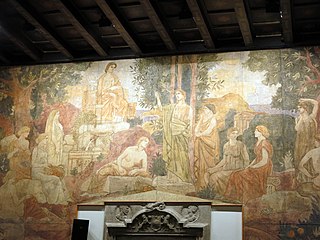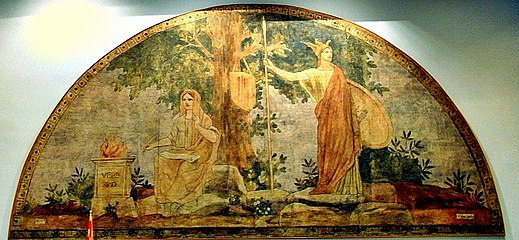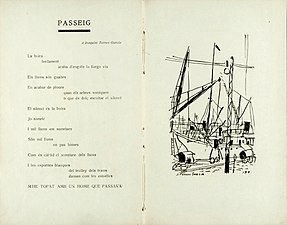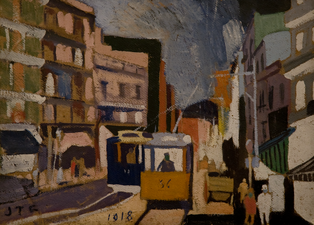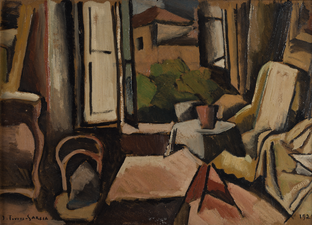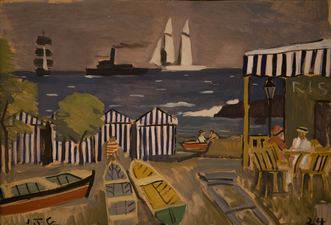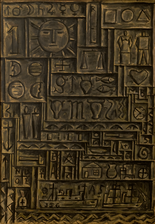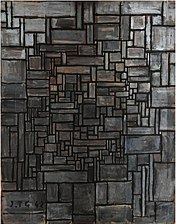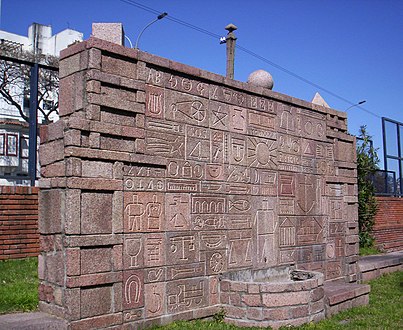Joaquín Torres-García

Joaquín Torres García | |
|---|---|
 Torres-García at the Sagrada Família in Barcelona in 1903 | |
| Born | Joaquín Torres Garcia 28 July 1874 Montevideo, Uruguay |
| Died | 8 August 1949 (aged 75) Montevideo, Uruguay |
| Nationality |
|
| Education | Escuela Oficial de Bellas Artes Barcelona |
| Known for | Painting, sculpture, writing, teaching, illustration |
| Movement | Modern art, noucentisme, constructivism, universal constructivism |
| Spouse | |
| Children | 4 |
| Website | https://jtorresgarcia.com/ |
Joaquín Torres-García (28 July 1874 – 8 August 1949) was a prominent Uruguayan-Spanish artist, theorist, and author, renowned for his international impact in the modern art world. Born in Montevideo, Uruguay, his family moved to Catalonia, Spain, where his artistic journey began. His career spanned several countries including Spain, New York, Italy, France, and Uruguay. A founder of art schools and groups, he notably established the first European abstract-art group, Cercle et Carré (Circle and Square), in Paris in 1929 which included Piet Mondrian and Kandinsky. Torres-García's legacy is deeply rooted in his development of Modern Classicism and Universal Constructivism.

Biography
[edit]1874
[edit]Joaquín Torres-García was born on July 28, 1874, in Montevideo, Uruguay, a bustling port city amidst the South American Pampas. He was the eldest child of Joaquim Torras Fradera, an immigrant from Mataró, Spain, and María García Pérez. His early years were spent in Almacen de Joaquín Torres, his father's general store. [1] "The picturesque store situated in the old Square of the Wagons, the arrival point of the raw material of the country for export to Europe. The colonial Montevideo had a port, trains, and a vibrant population dotted with countless gauchos wrapped in capes with whip ready in hand."[2] "Much of his early education in that predominantly agricultural society came from his observation of the things around him ... "[3]
In 1891, Torres-García's father moved the family back to Spain, where Torres-Garcia and his siblings acquired Spanish citizenship.[4] Torres-García studied with a local painter, and soon showed an aptitude for art. When the family moved to Barcelona, he enrolled in the School of Fine Arts in Barcelona (Escuela de Bellas Artes de Barcelona), the Baixas Academy (Academia Baixas) and the Saint Lluc Artists Circle.[5] "Torres-García and Picasso were contemporaries. Both began their artistic lives in modern Barcelona ... whose privileged epicenter was the cafe Els Quatre Gats ..."[6] Classmates included Ricard Canals, Manolo Hugue, Joaquim Mir, Isidre Nonell, Pablo Picasso, and Julio Gonzalez. Torres-García contributed his drawings to the principal newspapers and magazines of the time: La Vanguardia, Iris, Barcelona Cómica and La Saeta. In 1900, Torres-García experienced the loss of his father.
1900
[edit]Torres-García's first significant success came with his solo exhibition at the Salon La Vanguardia Gallery. Miguel Utrillo penned a review entitled 'Joaquin Torres-Garcia, Decorator,' which was featured in Pèl i Ploma. Accompanying the review were a portrait of Torres-García by Ramon Casas, photographs of several of Torres-Garcia paintings, including one on the magazine's cover, and his first article, 'Impressions'.[7]
In 1903, Antoni Gaudí commissioned Torres-García to create stained-glass windows for the Palma Cathedral. This project, spanning from 1902 to 1905, became a key event in his career. Torres-García worked on the Cathedral of Palma de Majorca, a Spanish Gothic masterpiece, crafting the lateral stained-glass windows and the small rose window in the apse. His interpretation of Marian symbols – the sun, the moon, the star, the well, the garden, the tower, the temple – were themes he revisited throughout his career. Following this, Torres-García received numerous commissions for murals, including work for the Church of San Agustin, the Church of the Divina Pastora, and the Torre del Campanar house.
Eugenio d'Ors, the originator of the term Noucentisme, lauded the works of Torres-García displayed at the Sala Parés in 1903. He wrote a text for Torres-García's exhibition at the Galeries Dalmau in 1912 and often mentioned his work in 'La Ben Plantada,' a book epitomizing the noucentisme movement. However, Torres-García did not align himself with D'Ors' views. His divergence was evident in two texts he published before the emergence of noucentisme around 1910: "Augusta et Augusta" (1904) and "La nostra ordinacio I el nostre cami" (1907). In classicism, Torres-García sought a model for order, a language, and a cultural reference point that would enable him to transcend realism and develop Catalan art on a universal scale. He eventually distanced himself from noucentista artists like Sunyer, Canals, Aragay, and D'Ors.
In 1907, Torres-García began his teaching career and soon became involved with the experimental school Colegio Mont d'Or, founded by his friend and progressive educator Joan Palau Vera. Breaking away from the conventional academic methods of the time, Colegio Mont d'Or eschewed traditional copy exercises from casts, prints, or books. Instead, drawing lessons were grounded in direct observation of reality, using common household objects, leaves, fruits, fish, flowers, and animals. This approach laid the groundwork for the vocabulary of his Universal Constructivism, emerging as a progressive pedagogical exercise.
Torres-García married the Spanish-Uruguayan painter Manolita Piña i Rubíes in 1908.[8] She would go on to found the Museo Torres García.[9] The couple had four children who were also notable artists, two girls named Olimpia Torres and Ifigenia and two boys named Augusto Torres and Horacio Torres.[10]
1910
[edit]
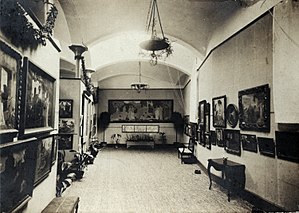
Torres-García journeyed to Brussels to undertake a painting project for a pavilion at the Brussels International World Fair. Following this, he spent an extended period in Paris, where he reconnected with friends and explored numerous museums and galleries. During this time, elements of cubism began to appear in his work, aligning with the theories presented in "Du Cubisme," published in 1912. This influence was evident in his art showcased at the 1912 Paris exhibition, organized by the Section d'Or. Additionally, his first visit to Italy and Switzerland introduced him to the principles of futurism.
In 1911, Torres-García showcased his painting 'Philosophy X Musa' at the sixth International Exhibition of Art in Barcelona, subsequently donating it to the Institut d'Estudis Catalans. Since its debut, this work has been consistently recognized by historians as a foundational piece of noucentisme. Later, Torres-García created a second version of this painting, which is now housed in the collection of the Reina Sofia Museum in Madrid.
In 1912, two exhibitions were held at the Galeries Dalmau: Torres-García (works from his Noucentista period) and Pablo Picasso, with drawings from his Blue Period (February - March 1912).[11][12][13] Torres-García published his first book, Notes sobre Art (Notes on Art), in May 1913. In the introduction, he wrote: "Aquestes curtes notes poden tenir interès, demes, per anar estretament lligades, com quelcom de viu, a tot o que arrencant de la nostra tradició, en el pensament i en la realitat, tendeix a formar el ver Renaixement e Catalunya" ("These short essays may be of interest also because they are closely related to, something that is alive, sprung from our tradition, in thought and in reality, to form the true Renaissance of Catalonia"). Torres-García then founded the Escuela de Decoración (School of Decoration/Decorative Arts) in Sarrià. "Prat de la Riba (president of the Council) had then his newly formulated conception of Catalan nationalism, and sees in the Mediterranean tradition proposed a positive content for the national profile, rich in spiritual substance."[14]
Prat de la Riba commissioned Torres-García frescoes for the atrium of the Municipal Palace of Barcelona, a 15th-century Gothic palace and seat of government in Catalonia.[15] During the next five years, he painted four large frescoes and studies for another two. The paintings became the new symbol of the Catalonia noucentista.[16] "In one of the frescoes ... Torres-Garcia represented a gigantic Pan-god with a quote from Goethe's 'Faust' at his feet: 'The temporal is only a symbol'. 'That is the key to all the poetics of Torres-García, the will to surrender to the ephemeral in order to reach eternity,' explained Llorens. For Torres-García, classicism was the door of a better future, not a brake for modernity."[17] Torres-García used iconostatic composition for pagan subjects adapted to modern themes, demonstrating that classicism is not unique to the Greeks. He painted the rhythm of a structure, as he described in "El Descubrimiento de si mismo" and "Evolucionista" (both published in 1917). Torres-García later used the same composition in his constructivist works. He designed, built, and decorated his home in Tarrasa ("Mon Repos") with frescoes, and invited friends and pupils to a housewarming party.[18]
In 1918, "Torres-García can be seen exploring the grid structure,' on the one hand as an inherent characteristic of a modern city and on the other as a form to explore the symbolic potential of everyday motifs. He also explored the potential for language within images, as in the 1916–17 drawing 'Descubrimiento de si mismo (Discovery of Oneself)."[19] He presented an exhibition at Galeries Dalmau of "Joguines d'Art (Artistic Toys)": "The toys teach children which are the correct colors, the correct forms. Each toy is a form, a color that mixes with other shapes and colors and finally becomes a whole: a dog, a car, a city. The toys guide future generations to acquire a natural eye."[20]
In 1919, Torres-García visited the United States: "He determined to take the pulse of the greatest and most modern of cities, New York."[1] "Despite being one of the most important artists of the moment, Torres García did not lull, and in 1920 he went to New York to continue exploring what they called modernity and began to cling to the ephemeral and temporal, what he drew in the city of skyscrapers connects with what John Dos Passos reflected in Manhattan Transfer."[21]
1920
[edit]Torres-García visited Paris for a second time with thirty-two crates of paintings after an encounter with his friend Picasso, who advised him to remain there: "Do not to go to America, because it will be like leaping into a void". His work evolved from classicism to Cubism, as Picasso's work did the reverse.[22] Wanting to experience a modern city, Torres-García traveled to New York with the intention of staying for two years. He lived in Manhattan: first on 49th Street, then on 14th Street and finally on West 29th Street. Torres-García continued his series of sketchbooks of the cities he visited, reflecting the city's movement and atmosphere. He painted a series of portraits, including one of Joseph Stella. Torres-García depicted Broadway's cityscape and people. He exhibited at the Whitney Studio gallery[23] and the Society of Independent Artists with Stuart Davis and Stanisław Szukalski in 1922, describing his work as "expressionistic and geometric at the same time, and very dynamic".[24]
Torres-García returned to Italy that year, developing his classic and evolutionistic works. Spain banned the Catalan language, including his writings. During this period, Torres-García's mother died. He settled in Villefranche-sur-Mer in 1925, and had another solo exhibition at Galeries Dalmau in Barcelona the following year.[25]
Torres-García returned to Paris for the third time in 1926,[22][26] and was a key animator of the interwar abstract movement over the next six years.[27] He exhibited 34 works, a series of large, classical nudes, and paintings from New York at the Galerie A. G. Fabre. "Forty works make up this presentation of Torres-Garcia first exhibit here at Galerie Fabre: frescoes, fragments of large murals, assembled architectural maquettes, still life or figures ... They show the artist under different aspects manifesting all the fiery wealth and complex diversity. Some urban landscapes will give an idea of the passage of Torres-Garcia by New York were a feverish spectacle of the business city captivated some time his artistic inquietude in search of its rhythm. Although he has played a major role in the development of the Mediterranean school, Garcia is bent with such a force towards his personal inclination he has always cleared away from the prejudices of isms (schools) that might limit his personal growth."[28] "However, by returning to the Classicism of his early work he made it clear that this was not an artistic language he had sought to vanquish through abstraction".[19] Torres-García was part of a May 1927 group show with Stanislaw Eleszkievicz and Runser at the Galerie d'art du Montparnasse, and had a solo exhibition of paintings at the Galerie Carmine from 16 to 30 June 1927.[29]
He had a solo exhibition at the Galerie Zak in December 1928, and was part of a group exhibition at the Galerie des Editions Bonaparte with John Graham, Kakabadze, Tutundjian, and Vantongerloo in August 1929. Torres-García then had another solo exhibition at the Galerie Carmine. As a correspondent for the Catalan literary magazine Mirador he wrote a series of articles on painters, including an interview with Georges Braque. "But if Mondrian wanted to explore modernity by a single path, he (Torres-García) wanted to get to the bottom by two paths at the same time, starting from reason but not avoiding intuition".[21]
1930
[edit]
Constructivism to Torres-García was the same as neoplasticism just a label. What mattered was creating a new image a new language within a traditional composition,[30] in which he balanced representation and abstraction with signs.[30] He had two solo exhibitions in 1931 at the Galerie Jeanne Bucher and the Galerie Percier, and a group show in October of that year at the Galerie Georges Petit with Giacometti, Ozenfant, Max Ernst, Miro, and Salvador Dalí.[31] The following year, Torres-García presented a solo exhibition of paintings and sculptures at the Galerie Pierre. "The friendship between van Doesburg and Torres-Garcia will create the foundations for the three most important movements to promote abstract art: "Cercle et Carre" (1929–1930), "Art Concret" (1930); and "Abstraction-Creation"(1931–1936)."[27] He founded the magazine Cercle et Carre with van Doesburg, and assembled a group of 80 artists.[2] Torres-García left for the Community of Madrid and finished the manuscript of Arte Constructivo, which was published in 1935 under the name of "Estructura" and dedicated to his friend Piet Mondrian.
He returned to Montevideo in April 1934 for the first time since childhood. In August of that year, Torres-García exhibited paintings, sculptures and the work of the Cercle et Carre group and reedited the magazine as Circulo y Cuadrado.[22] He published Historia de mi vida (Story of My Life) an autobiographical novel, in 1937. Two years later, Torres-García began work on the pink-granite Monumento Cosmico, a representative work from this period.[22]
1940
[edit]Torres-García announced the closing of the Association of Constructive Arte school in the last of 500 lectures he gave between 1934 and 1940. In 1941, he published Ciudad sin Nombre (A City With No Name). Torres-García presented a solo exhibition at the Society of Architects of Uruguay in November of that year. In July 1942, he received a visit from Committee of Inter-American Relations curator Lincoln Kirstein and Nelson A. Rockefeller.[22] Torres-García founded the Taller Torres Garcia, similar to the European Bauhaus, two years later; the school included future artists Olga Piria, Gonzalo Fonseca, José Gurvich, Alceu Ribeiro, Julio Alpuy, Raquel Orzuj, Lily Salvo and his sons, Horacio and Augusto. Torres-García returned to the maternity theme from his 1914 Barcelona mural that year, creating a mural for the Sindicato Médico del Uruguay; he also painted seven monumental mural frescoes for the Hospital Saint Bois tuberculosis sanitarium. Torres-García died on 8 August 1949 while preparing two exhibitions: one at the Sidney Janis Gallery in New York and other at the Pan American Union in Washington. He died of a heart attack.
Influences and legacy
[edit]Influenced by European, North American and South American modern art,[32] his work evolved into a more abstract structure; Picasso, seven years younger, was a follower.[32] Joan Miró was a student of Torres-García in Barcelona who acknowledged his teacher's influence,[26][33] and Torres-García's constructive paintings influenced the evolution of Latin American geometric abstraction.[34]
Works
[edit]Mon Repos frescoes
[edit]Frescoes Torres-Garcia created in 1914 in his home built in the surrounding suburbs of Barcelona.
Palau de la Generalitat (1913-1917)
[edit]The Joaquín Torres-García Hall in the Palace of the Generalitat of Catalonia houses the frescoes painted by the artist on the walls of Salon Sant Jordi from 1912 to 1916, commissioned by President of the Council and the Commonwealth of Catalonia Enric Prat de la Riba. Torres-García worked on the first mural for 13 days, beginning on 28 July 1912, and it was unveiled on 13 September of that year.[1] The four completed frescoes are entitled La Catalunya Eterna (Catalunya Eternal), L'Etat d'Or (The Golden Age), Les Muses (The Muses) and Lo temporal no es mes que simbol (The Temporal is Nothing But a Symbol). The murals were hidden from 1926 to 1966.[4]
Paintings (1918–1943)
[edit]- Poemes en ondes hertzianes
- Linòleum
- Bodegom
- Passeig
- Interior-Salvat
- Paisaje de ciudad
- Interior
- Paisaje de playa
- Figuras
- Pintura
- Pintura constructiva 5
- Figuras sobre uma estrutura (1930)
- Contraste
- Pintura constructiva 2
- Arte universal
- Arte constructivo
Monumento Cosmico (1938)
[edit]Selected writings
[edit]- Augusta et Augusta, Barcelona, Universitat Catalana, 1904
- Dibujo educativo en el colegio Mont D'Or, Barcelona, 1907
- Notes sobre Art, Barcelona, 1913
- Diàlegs, 1914
- Descubrimiento de sí mismo, 1914
- Consells als artistes, Barcelona, Un enemic del poble, 1917
- Em digué tot aixó, Barcelona, La Revista, 1917
- D'altra orbita, Barcelona, Un enemic del poble, 1917
- Devem Caminar, Barcelona, Un enemic del poble, 1917
- Art-Evolució, Barcelona, Un enemic del poble, 1917
- El Públic i les noves tendéncies d'art, Barcelona, Velli nou, 1918
- Plasticisme, Barcelona, Un Enemic del poble, 1918
- Natura i Art, Barcelona, Un Enemic del poble, 1918
- L'Art en relació al home etern i l'home que passa, Sitges, Imprenta El eco de Sitges. 1919
- La Regeneració de si mateix, Barcelona, Salvat Papasseit Editor, 1919
- Poemes en ondes hertzianes, 1919 (illustrator)
- Foi, París, 1930
- Ce que je sais, et ce que je fais par moi-même, Losones, Suiza, 1930
- Pére soleil, París, Fundación Torres García, 1931
- Raison et nature, Ediciones Imán, París, 1932
- Estructura, Montevideo, 1935
- De la tradición andina: Arte precolombino, Montevideo, Círculo y cuadrado, 1936
- Manifiesto 2: Constructivo 100 %, Montevideo, Asociación de Arte Constructivo, 1938
- La tradición del hombre abstracto (Doctrina constructivista). Montevideo, 1938
- Historia de mi vida. Montevideo, 1939
- Metafísica de la prehistoria indoamericana, Montevideo, Asociación de Arte Constructivo, 1939
- Manifiesto 3, Montevideo, Asociación de Arte Constructivo, 1940
- La ciudad sin nombre. Montevideo, Uruguay, Asociación de Arte Constructivo, 1942
- Universalismo Constructivo, Montevideo, 1944
- Con respecto a una futura creación literaria y dos poemas, Divertimento 1 y Divertimento 11, Montevideo, Revista Arturo, 1944
- La decoración mural del pabellón Martirené de la colonia Saint Bois. Montevideo, Gráficas Sur, 1944
- En defensa de las expressiones modernas del arte, Montevideo, 1944
- Nueva escuela de arte de Uruguay. Montevideo, Asociación de Arte Constructivo, 1946
- La regla abstracta. Montevideo, Asociación de Arte Constructivo, 1946
- Mística de la pintura, Montevideo, 1947
- Lo aparente y lo concreto en el arte, Montevideo, 1948
- La recuperación del objeto, Montevideo, 1948
Selected paintings
[edit]- La colada, oil on canvas, 1903
- La casa del lavadero, oil on canvas on wood, 1903, Museo Abadía de Montserrat, Barcelona
- El pintor con su familia 1917
- Construction in White and Black at the Museum of Modern Art (1938)
- Constructive City with Universal Man
- Composition
- Construcción con dos máscaras (Construction with Two Masks), 1943. Pérez Art Museum Miami, United States[35]
Major exhibitions
[edit]- April 12 - June 29, 2018, The Worlds of Joaquín Torres-Garcia, Acquavella Galleries, New York.
- 25 October 2015 – 15 February 2016, Joaquín Torres-García: the Arcadian modern, Museum of Modern Art, New York
- 29 December 2013 – 2 March 2014, Art & Textiles: fabric as material and concept in modern art from Klimt to the present, Kunstmuseum Wolfsburg, Germany
- 22 Apr 2013 – 30 Jun 2013, From Picasso to Barceló: Spanish Sculpture of the 20th Century, National Art Museum of China
- 16 May – 11 September 2011, Torres-García a les seves cruïlles (Torres-García at his Crossroads), Museu Nacional d'Art de Catalunya (MNAC), Barcelona
- 27 March 2009, Trazos de Nueva York, Museo Torres-Garcia, Montevideo
- December, 2008 - April 2009, Torres García a Vieira da Silva, 1929–1949, IVAM, Valencia, Museu Colecção Berardo, Portugal
- 8 October 2005 – 15 February 2006, Le feu sous les cendres : de Picasso à Basquiat, Fondation Dina Vierny-Musée Maillol, Paris
- 7 October 2005 – 19 February 2006, Obras maestras del siglo XX en las colecciones del IVAM, Valencia
- 25 November 2003 – 11 April 2004, Torres-Garcia, Museu Picasso, Barcelona
- 2003, Jean-Michel Basquiat-Gaston Chaissac-Jean Dubuffet-Joaquin Torres-Garcia, Jan Krugier Gallery, New York
- September 2002, From Puvis De Chavannes to Matisse and Picasso : Toward Modern Art, Palazzo Grassi, Venice
- 24 May – 8 September 2002, Joaquin Torres-Garcia : un monde construit : Musée d'art moderne et contemporain, Strasbourg
- 31 May – 23 August 1992 Joaquin Torres-Garcia en Theo van Doesburg, The Stedelijk Museum, Amsterdam
Bibliography
[edit]- Joaquim Torres i García; Estherde Cáceres, Carmelo de Arzadum, Alfredo Cáceres, Pablo Purriel, Juan R. Menchaca, i Guido Castillo, the decoration mural of the Martirené pavilion of the colony Saint Bois. Murals paintings of pavilion J.J. Martirené Hospital of the colony Saint Bois. South graphs. Montevideo, 1944.
- Claude Schaefer, Joaquin Torres García. Ed. Poseidón. Library Argentina de Arte. Buenos Aires, 1949.
- Josep Francesc Ràfols, Biographical Dictionary of artists of Catalonia. Torres-Garcia, Joaquin, Volume III, p. 153. Barcelona, Milà, 1966.
- Daniel Robbins, Joaquin Torrers-Garcia, 1874–1949. Ed. by Museum of Art Rhode Island School of Design. Providence, 1970. ISBN 0-911517-23-5
- Enric Jardí, Torres García. Editorial Polígrafa, S. A., Balmes, 54 – 08007, Barcelona, 1973. ISBN 84-343-0180-6
- Jacques Lassaigne, Ángel Kalenberg, Maria Helena Vieira da Silva, Michel Seuphor, Jean Hélion, Torres-Garcia. Construction et Symbols. Published by the Museum of Modern Art of Villa of Paris. Catalogue of the exhibition made between June and August 1975. Paris, 1975.
- Jacques Lassaigne, Torres-Garcia. Works destroyed in the fire of the museum of modern art of Rio de Janeiro, Published by the Torres Foundation Garci'a. Montevideo, Uruguay. 1981.
- Margit Rowell, Theo van Doesburg, Joaquín Torres-García, Torres Garcia Structure. Paris-Montevideo 1924–1944 Edited by Foundation Joan Miró. Catalogue of the exhibition in the Fundació Joan Miró, Parc de Montjuic in March 1986. Barcelona, 1986.
- Ángel Kalenberg, Seis Maestros De La Pintura Uruguaya: Juan Manuel Blanes, Carlos Federico Saez, Pedro Figari, Joaquin Torres García, Rafael Barradas y José Cúneo. Edited by Museo Nacional de Bellas Artes de Buenos Aires. Catálogo de la exposición realizada entre Septiembre y Octubre de 1987. Avda. del Libertador, 1473. Buenos Aires, 1987. Montevideo, 1987.
- Alicia Haber, Joaquin Torres Garci'a. Eternal Catalonia. Sketches and drawings for the fresh airs of the Delegation of Barcelona. Edited by Foundation Torres García. Montevideo, 1988.
- María Jesús García Puig, Joaquin Torres Garcia and the Constructive Universalismo: The education of the art in Uruguay. Editions of Hispanic culture. Collection Art. Madrid, 1990. ISBN 84-7232-558-X
- Jorge Castle, Nicolette Gast, Eduardo Lipschutz-Villa, and Sebastián López, The antagonistic Link. Joaquin Torres Garcia-Theo van Doesburg. Published by Institute of Contemporary Art. Ámsterdam, 1991.
- Pilar Garcia-Sedas, Joaquin Torres the Striped Garcias and Rafael. Dialeg escrit: 1918–1928. Publicacions of l' Abbey of Montserrat. Barcelona, 1994. ISBN 84-7826-531-7
- Joan Sureda Pons, Narcís [Narciso], Comadira and Mercedes Doñate, Torres Garcia: Pintures de Mon Repos, Published by the Museum of modern Art of the Museum of Art of Catalunya and the Caixa of Terrassa. I catalogue of the exhibition that place in the museum of modern art of the MNAC took, and in the Cultural Foundation of the Caixa of Terrassa. Barcelona, January 1995.
- Pilar García-Sedas, Joaquim Torres Garcia. Epistolari Català: 1909–1936. Curial Edicions Catalan. Publicacions of l' Abbey of Montserrat, Barcelona, 1997. ISBN 84-7826-839-1
- Joan Sureda Pons, Torres Garcia. Classic passion. Akal editions/contemporary Art. Number 5. Madrid, 1998. ISBN 84-460-0814-9
- Carlos Pérez, Pilar Garcia-Sedas, Mario H. Gradowczyk and Emilio Ellena, Aladdin Toys. Them joguines of Torres Garcia. Published by the IVAM. I catalogue of the exhibition that took place in the Valencian Institute of Modern Art in September 1998.
- Miguel Angel Battegazzore, the plot and the signs, Impresora Gordon, S.A. Av. General Rondeau 2485, Montevideo, 1999.
- Gabriel Peluffo Linari, History of the Uruguayan painting. Editions of Eastern band limited liability company. Gaboto 1582. Montevideo 11200. Uruguay, 1999 imaginary Tomo the 1 National-regional (1830–1930) from Blanes to Figari Tomo 2 Between localismo and universalismo: Representations of modernity (1930–1960).
- Michael Peppiatt, Jean-Michel Basquiat - Gaston Chaissac - Jean Dubuffet - Joaquin Torres-Garcia, New York, catalogue of the exhibition that took place in Jan Krugier Gallery, 2003.
- Tomàs Llorens, Emmanuel Guigon, J.Torres-Garcia Un monde construit, Hazan, Strasbourg, 2002, catalogue of the exhibition that took place in Musée d'Art Moderne et Contemporain de Strasbourg, 24 May to September 2002.ISBN 2-85025-827-X
- Tomàs Llorens, Emmanuel Guigon, Juan José Lahuerta, J. Torres-Garcia, Editorial Ausa y Institut de Cultura de Barcelona, Barcelona, 2003, catalogue of the exhibition that took place in Museo Picasso de Barcelona, 25 November to 11 April 2004.ISBN 84-88810-63-6
- Nicolás Arocena Armas, Eric Corne, Marina Bairrão, Emmanuel Guigon, Domitille D'Orgeval, La ituicion y la Estructura, Lisboa, Museo Coleccao Berardo, 2008.ISBN 978-84-482-5105-5
- Tomás Llorens, Nicolás Arocena Armas, Torres-Garcia a les seves cruilles-Torres-Garcia en sus encrucijadas. Barcelona, Spain: Museu Nacional d'Art de Catalunya 2011.
- Llorens, Tomas. Arocena Armas, Nicolas, J.Torres-Garcia, New York, Joaquin Torres-Garcia Archive, 2011. Notes
References
[edit]- Arocena Armas, Nicolas. Torres-Garcia- Pythagoras- Plato A Geometric Dialogue, or the Eye of the Soul, Lisboa, Museo Coleccao Berardo, 2008
- Arocena Armas, Nicolas. Biography. Torres-Garcia a les seves cruilles-Torres-Garcia en sus encrucijadas. Barcelona, Spain: Museu Nacional d'Art de Catalunya 2011.
- Llorens, Tomas.Torres-Garcia a les seves cruilles-Torres-Garcia en sus encrucijadas. Barcelona, Spain: Museu Nacional d'Art de Catalunya 2011
- Llorens, Tomas. J.Torres-Garcia, New York, Joaquin Torres-Garcia Archive, 2011.
- Llorens, Tomas. Torres-Garcia. Editorial Ausa, 2003
- Robbins, Daniel. Joaquin Torres-Garcia 1874–1949. Providence, Museum of Art Rhode Island School of Design, 1970
- Rafols, F. Josep, Torres-Garcia, Barcelano, 1926.
- Schaefer, Claude. Joaquin Torres-Garcia. Buenos Aires, Editorial Poseidon, 1949.
- Sureda Pons, Joan. Torres-Garcia, Pasion Clasica. Madrid, Ediciones Akal, 1998
- Surio, Dario. Torres-Garcia. Rose Fried Gallery, New York, 1965
- Torres-Garcia, Joaquin. Historia de mi vida. Montevideo, Ediciones Asociacion Arte Constructivo, 1939.
- ^ a b c Robbins, Daniel (1970). Joaquin Torres-Garcia 1874–1949. Providence: Museum of Art, Rhode Island School of Design.
- ^ a b Schaefer, Claude (1949). Joaquin Torres-Garcia. Buenos Aires: Editorial Poseidon.
- ^ Doyle Duncan, Barbara (1971). Joaquin Torres-Garcia. University of Texas.
- ^ a b Roca, Alfons (2012). El Palau de la Generalitat de Catalunya Resum de 600 anys d'art. Barcelona: Generalitat de Catalunya. p. 22.
- ^ Surio, Dario (1965). Torres-Garcia Memorial Exhibition. New York: Rose Fried Gallery.
- ^ Llorens, Tomas (2011). J. Torres-Garcia. New York: Joaquin Torres-Garcia Archive.
- ^ Utrillo, Miguel. "Joaquin Torres-Garcia, Decorator". Pèl i Ploma No. 74
- ^ EFE (14 June 1994). "Manolita Piña, viuda del pintor Joaquín Torres". El País (in Spanish). ISSN 1134-6582. Retrieved 25 May 2024.
- ^ "El Museo Torres García". Museo Torres García. Archived from the original on 6 October 2010. Retrieved 24 May 2024.
- ^ Clarín, Redacción (2 April 2024). "¿Quiénes fueron las mujeres del Taller Torres García que llenan hoy un museo en Uruguay?". Clarín (in Spanish). Retrieved 25 May 2024.
- ^ Josep Palau i Fabre, Picasso a Catalunya, Edicions Polígrafa, S.A., Barcelona, 1975, p. 196
- ^ Exposició de dibuixos i pintures de Joaquim Torres García, Galeries Dalmau, 1912 (exhibition catalogue)
- ^ Picasso, Veu de Catalunya, 7 March 1912
- ^ Marquina, Eduardo (1933). J. Torres-Garcia. Madrid. p. 4.
{{cite book}}: CS1 maint: location missing publisher (link) - ^ Wheeler, Monroe (1971). Joaquin Torres-Garcia. University Art Museum University of Texas at Austin. p. 3.
- ^ Roca, Alfons (2012). El Palau de la Generalitat de Catalunya Resum de 600 anys d'art (PDF). Barcelona: Generalitat de Catalunya. p. 22. Archived from the original (PDF) on 6 October 2015.
- ^ Penelo, Lidia (17 May 2011). "Las encrucijadas de Torres-García llegan al MNAC". Publico.
- ^ Woodcut invitation by artist dated 1915. ill. Eric Jardi 1973
- ^ a b Roe, Jeremy (2011). "Creative Forks". Apollo.
- ^ Molins, Javier (2003). Grandes Artistas: La mirada de los descendientes. Valencia: IVAM Institut Valencia d'Art Modern. p. 56. ISBN 84-482-3564-9.
- ^ a b Lidia Penelo. "Las encrucijadas de Torres-García llegan al MNAC". publico.es. Retrieved 29 September 2017.
- ^ a b c d e Arocena Armas, Nicolas (2011). Torres-Garcia a les seves cruilles-Torres-Garcia en sus encrucijadas. Barcelona: Museu Nacional d'Art de Catalunya. p. 232. ISBN 978-84-8043-232-0.
- ^ Annual exhibition of painting and sculpture by members of the Club, New York, N.Y., Whitney Studio Club, 1922
- ^ "Joaquín Torres-García (1874–1949) One Man, Three Continents". Joaquín Torres-García Archive. Retrieved 5 October 2015.
- ^ Catàleg de l'Exposició de Joaquim Torres García, organitzada a les Galeries Dalmau del Passeig de Gràcia, del 12 al 25 de juny 1926 Barcelona
- ^ a b "The Worlds of Joaquín Torres-García". Wall Street International. 10 April 2018. Retrieved 14 May 2020.
- ^ a b Llorens, Tomàs (May 2011). Torres-Garcia a les seves cruilles-Torres-Garcia en sus encrucijadas. Barcelona, Spain: Museu Nacional d'Art de Catalunya. p. 18. ISBN 978-84-8043-232-0.
- ^ Juan de Gary. Mai 1926 Excerpt from the catalog of the exhibition at Galeri A.G. Fabre 20 Rue de Miromesnil du 7 au 20 de Juin 1926. Translated from French
- ^ Catàleg de l'Exposició de Joaquim Torres García, organitzada a la Galerie Carmine, del 16 al 30 de juny. París. Pròleg de Joseph Milbauer
- ^ a b Llorens, Tomas (2003). Torres-Garcia. Editorial Ausa. p. 255. ISBN 84-88810-63-6.
- ^ "Expositions". Esprit Français. 15 November 1931.
- ^ a b Tomas Llorens; Abigail McEwan; Frederic Tuten. The Worlds of Joaquin Torres-Garcia.
- ^ Market, The Editors of Art. "The Worlds of Joaquín Torres-García". Retrieved 14 May 2020.
{{cite web}}:|first=has generic name (help) - ^ Clifford, Benjamin (1 May 2018). "The Worlds of Joaquín Torres-García". The Brooklyn Rail. Retrieved 14 May 2020.
- ^ "Construcción con dos máscaras (Construction with Two Masks) • Pérez Art Museum Miami". Pérez Art Museum Miami. Retrieved 8 September 2023.
External links
[edit]- http://www.philamuseum.org
- National Gallery of Art
- http://www.guggenheim.org
- Museo Centro de Arte Reina Sofia
- Museo Thyssen-Bornemisza
- Albright-Knox Art Gallery
- Rhode Island School of Design Museum
- Smithsonian Archives of American Art
- Museo Torres García – Montevideo
- LACMA
- Joaquin Torres Garcia, Museum of Modern Art
- Metropolitan Museum of Art
- http://www.musee-lam.fr/





